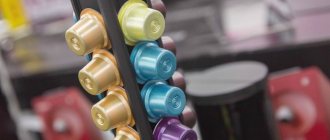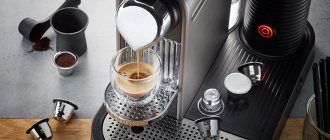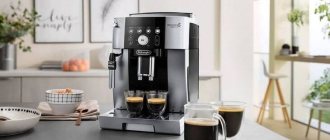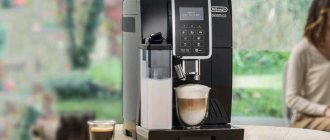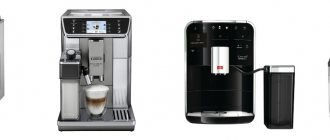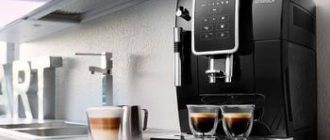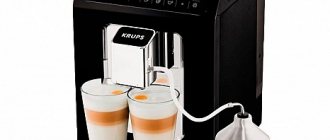Busy coffee lovers often lament the lack of time to prepare an invigorating drink. Even coffee makers did not save the situation, requiring regular cleaning to remove wet grounds. In 1986, the famous instant coffee manufacturer Nestle introduced a new technology to the market - capsule coffee under the Nespresso SA brand. Since then, a lot of water has passed under the bridge, and many major players in the coffee market are selling the new product. The attitude towards her is ambiguous. Some praise it to the skies, but some disparage the technology as a marketing gimmick. We invite you to form your own opinion about coffee capsules with us.
What is coffee capsules?
Those who have never personally encountered it, but only heard about the new product or saw it packaged on supermarket shelves, often consider coffee capsules to be an analogue of bagged tea. This is not the right way to look at things. Let's figure out what this small container is?
- The shell is made of aluminum foil or plastic . Under the influence of light and air, coffee loses its aromatic properties, so manufacturers have done everything possible to protect the contents of the container. The walls are opaque, and the capsule itself is equipped with a valve that removes carbon dioxide from the package.
Since 2008, biodegradable options have appeared on the market that are environmentally friendly. Since then, many manufacturers have been trying to produce their products in such environmentally friendly shells.
- A portion of ground coffee is packed into the capsule . Coffee capsules are produced by large coffee companies, so the containers contain the same product that you will find on supermarket shelves, in large branded packages.
Until recently, capsules were only disposable, according to the principle - one container - one brew. Relatively recently, an innovation has appeared - empty capsules for self-filling. Ground coffee is placed in them and the lid is tightly closed. The result is suitable for immediate use. After preparation, the reusable device can be removed from the coffee maker compartment, cleaned and used again.
What is a capsule coffee maker?
In order to enjoy a cup of drink from a container, you will first need a special coffee machine, which is called a capsule coffee machine. It cannot prepare coffee using conventional technology; it is intended only for packaged coffee powder. You can buy several types of popular devices in stores.
Nespresso coffee maker
A pioneer of the market, designed only for capsules from Nestle, to the point that the products of other manufacturers until 2013 were rendered unusable by a special device called the “harpoon mechanism”. Thanks to him, the wrong capsules got stuck in the machine and were not suitable for making coffee.
Since 2012, several companies have won court cases to gain official permission to produce Nespresso-compatible capsules. These are the British Dualit Ltd and the European holding EEC. So the products of these brands are also suitable for Nespresso capsule coffee makers.
Nestle produces two types of capsules for its coffee makers - Nespresso and Dolce Gusto. Both types can be single or reusable.
Coffee maker Tassimo
The second largest player in the market is the American company Mondelez and their Tassimo brand is widely represented in our chain stores. Unlike its competitor, the Americans relied on the wide compatibility of capsules with their coffee machines. Tassimo is suitable not only for branded packaging, but also for products from the same Nestle and other, smaller manufacturers. The combined efforts of the Americans and their European counterparts DE Master Blenders allow customers to enjoy capsules with a variety of Jacobs and Carte Noire varieties. They are also sold in Tassimo capsules.
Other manufacturers
Well-known manufacturers of household appliances have turned their attention to capsule coffee makers. Corresponding devices appeared in the assortment of Bosh, Delonghi, Krups. The key difference between them is which manufacturer's capsules the coffee makers are compatible with. For example, Krups only works with Nespresso.
In addition, some European brands produce capsules of popular standards. For example, the Italian brand Di-Maestri produces compatible capsules of the Dolce Gusto, Nespresso, Lavazza standards, as well as blends for its own coffee machines.
The names of capsule coffee makers from well-known manufacturers use a direct indication of what type of capsule they are compatible with. For example, Bosh Tassimo or Delonghi Nespresso.
Rating of the best brands of capsules for Nespresso coffee machines
Despite the wide range of Nespresso coffee for coffee machines of its brand, many use capsules from other manufacturers. Based on consumer reviews, a rating of the best varieties presented in retail and online stores was compiled.
- L'OR Espresso Lungo Profondo. The French blend of 100% Arabica coffee is known to Russian customers as “Lungo”. Capsules are designed for preparing espresso of increased volume. Medium roast coffee has a spicy-nutty taste with notes of almond and a hint of licorice in the aftertaste.
- Starbucks Blonde® Espresso Roast. Swiss coffee of medium strength with a mild flavor characteristic of a light roast. The Arabica beans for this variety are grown in Latin America. Suitable for preparing 25 ml espresso and ristretto. The taste will be even more delicate if you add milk or cream to the drink.
- Espressio Caffe Espresso. A blend of Arabica beans from Central America and South Africa. The drink brewed from these capsules has the maximum degree of strength and richness. It is prepared from dark roasted beans, resulting in a rich coffee color. It has a pleasant tart, bitter taste. Capsules are produced in Italy.
- Jardin Ristretto. A popular company in Russia also produces capsules for Nespresso machines. The product line includes five items, among which the softest is Vivo, which has a soft berry sourness in the mouth, and the strongest is Ristretto, loved by connoisseurs for its rich taste with hints of chocolate. The fair half of coffee fans especially appreciate soft Vanilla.
- Dio Caffe Super Gusto. This Italian blend will appeal to those who like bitterness in their coffee. The basis of the blend is Robusta, and it contains only 15% Arabica. Thanks to this, the taste of the drink is very rich.
When choosing capsules in a store, you must first make sure that they are compatible with the coffee machine - information about this is placed on the packaging. When preparing, you should follow the manufacturer's recommendations regarding the volume of the drink. This will help to better reveal the advantages of the variety.
How to prepare coffee capsules?
Disposable capsules
- We take one capsule out of the package and place it in the special slot of the coffee maker.
There is no need to open, damage or puncture the packaging! The device will do everything on its own.
- Close the lid and turn on the device. If necessary, select the desired recipe.
- In the coffee maker, the lid and bottom are simultaneously perforated, after which steam under pressure is passed through the ground powder. Hot water is then sprayed through the bottom into the container. The aromatic drink enters the cup through a hole in the lid.
- The used capsule is removed.
Reusable capsules
Nespresso capsules simply need to be filled with the coffee of your choice, closed and placed into the machine's slot with the loop facing down.
Dolce Gusto capsules have a more complex structure and therefore require a special algorithm for use.
- Place the first filter in a plastic container.
- Pour the required amount into the capsule and cover with a second filter, and then with a lid.
- Place the capsule in the opening of the coffee maker.
The further preparation process is no different from the usual operation of a capsule coffee maker. The reusable capsule is already perforated, so a stream of pressurized air passes through it freely, which mixes the contents and enriches it with oxygen. Then a hot stream of water is passed through the powder and the finished drink flows into the cup.
There is no need to throw away the reusable container. It should be removed from the nest, cleaned of coffee sediment and washed. One capsule can be used 30 to 50 times.
How to brew a “capsule” correctly
These containers are equipped with an airtight foil lid. To prepare an aromatic drink with their help, you need to insert the capsule into the device between two filters.
In this position, after the start, the cup is pierced on both sides, after which the capsule is filled with hot water at one end, and the finished coffee is poured out at the other end. Disposable cups must be recycled, but there are also reusable cups that need to be washed after brewing.
You will be interested in: Rating of the TOP 7 best electric mini-ovens: selection rules, characteristics, reviews
The peculiarity of preparing capsule coffee is that water heated to the optimal temperature enters the container under a pressure of 10-20 bar. This is what provides a rich, strong taste, which is distinguished by a greater development of the aroma of coffee beans than in other types of machines.
Where to buy capsule coffee?
Coffee capsules are widely available and can be purchased at various outlets.
- In grocery supermarkets. The larger the store, the greater the assortment on the shelves.
- In hardware stores. The sale of capsule coffee makers prompted retailers to think about selling capsules for them. Therefore, in large shopping centers, among the samples of coffee machines, you can see packaging of capsules from various manufacturers.
- In the online store. There is a choice on specialized websites or on thematic portals selling ground coffee.
Nespresso coffee
Nespresso is a subsidiary brand of Nestle. Initially, the company specialized in the luxury segment, but since 2006, the management decided to expand the target audience and launched a retail direction, trying to cover the market in the field of office and home coffee brewing.
Back in 1976, one of Nestle's employees, Eric Favre, traveling with his lover in Italy, visited a coffee shop where the barista was preparing a drink by passing steam through the ground beans several times. This led the engineer to the original idea of brewing coffee using capsules with a membrane and filters. It took almost 10 years to bring the bold idea to life. The first capsule machine was released in 1986.
At first, Nespresso had to fight competition in the market. But thanks to a competent marketing policy, within a few years the whole world knew about the new brand. The demand for coffee machines and capsules for them grew rapidly. In 1989, a special Nespresso club was created, which included many luxury people who appreciated the taste of the drink. And in 1991, the company entered the export market, quickly winning fans in the USA and France.
On a note! Nespresso’s marketing policy is interesting: regardless of whether the client wants to purchase coffee in an offline or online store, purchase is possible only by pre-order.
The popularity of the brand is growing every year. The range of products is also increasing. Since 2010, sales of Nespresso coffee have more than tripled. Today, the company's products can be purchased in 60 countries, where 340 branded boutiques operate.
How to choose coffee capsules?
Today's capsule coffee market in Europe and Russia is controlled by two largest manufacturers - Nestle with the Nespresso and Dolce Gusto brands and Mondelez with the Tassimo brand. The determining factor in choosing coffee is the characteristics of the purchased coffee maker. If it is designed to work only with capsules from a specific manufacturer, then you will have to buy them.
If there is a choice, as, for example, in the case of the Tassimo coffee maker, then you should pay attention to the following factors.
- Capsule material . Plastic often imparts an off-flavor to the drink; aluminum is inert and has no effect on the coffee. That's why connoisseurs prefer metal containers.
- Coffee brand . It does not always coincide with the manufacturer of the capsules, since ground coffee of different brands is packaged in containers. Choose products you already know to get guaranteed quality. Capsules are purchased either in packs or individually, so you can buy several samples to try different recipes.
The packages of the capsules contain a mark indicating which coffee makers they are suitable for.
Cost of capsules
The most pressing issue, of course, is price. Each manufacturer has its own policy.
Disposable capsules
- Nestle. The cost of one capsule of the Dolce Gusto brand ranges from 18 to 30 rubles, depending on the type and quantity of products purchased. When purchasing 1 package of 16 pieces, the price varies from 320 (espresso) to 480 rubles (cappuccino). Nespresso capsules are more expensive - from 35 to 50 rubles per piece. They are aimed at the high price segment, are offered in a larger assortment, with different tastes and even differ in capsule design. However, this does not significantly affect the taste of the finished drink.
- Tassimo. The average price of a capsule is 22-26 rubles. A pack of 16 pieces can be purchased at prices ranging from 400 rubles (Jacobs Latte) to 500 rubles (Carte Noire Intense).
- Gradually, the market is filled with other offers. For example, Squesito capsules are gaining popularity. They complete Philips capsule coffee makers; the cost of these containers is from 35 rubles for 1 piece. The pricing policy of most manufacturers follows the cost of the leaders.
Reusable capsules
- Nespresso. One piece will cost 180-220 rubles. They are rarely sold one at a time, more often in a set of 3.5 or 10 pieces. The minimum price for a set of three units is 750 rubles. The resource of one capsule is enough to prepare 30-33 cups of coffee.
- Dolce Gusto. A unit costs from 350 to 400 rubles, but sets of 2-6 pieces are most often on sale. The minimum price is 800 rubles for a set of two capsules. One resource is enough to get 50-55 cups of drink.
Reusable capsules
One of the main disadvantages of capsule coffee machines is the limited range of drinks. Reusable capsules partially correct this, although such containers are not officially supported by coffee machine manufacturers.
It should be understood that this saving option is not always appropriate. The manufacturer takes into account everything from the steam pressure that passes through the container to the operation of the piercing mechanism. Third-party manufacturers most often produce reusable imitation, which can be filled with any grain.
Despite the fact that such capsules can be reused in a coffee machine, this makes the brewing procedure more complex and kills the main advantages of capsule devices - simplicity and speed.
Popular manufacturers of reusable capsules:
- Nespresso – Coffeduck, Capsulin, Emohome, Xawax;
- Tassimo - some Chinese companies produce reusable containers made of ordinary plastic, but due to the high pressure (for which they are not intended), coffee is practically not brewed;
- Dolce Gusto – Sealpod (stainless steel or silicone).
In general, buying empty plastic capsules is not recommended . Apart from Emohome and Coffeduck, they are inferior to branded containers. Stainless steel cases, unlike plastic ones (25-30 brews), are designed for reusable use. However, their high price negates any attempts to save money. As for quality, original products will always take priority according to all evaluation criteria.
The only reason to consider reusable containers is to use your own beans of choice and mix blends, but in this case it is better to purchase a carob coffee maker, which makes filling and cleaning much easier and more convenient.
Cost of capsule coffee makers
To prepare coffee in capsules, you also need a coffee maker of a suitable design. How much will it cost?
- Tassimo. An original coffee maker can cost from 7,200 (Picollo model) to 13,200 rubles (Circolo model).
- Nespresso. The minimum cost is from 7900 rubles, like the Inissia model. Top models have much higher prices. For example, Lattissima Pro costs 45,000 rubles, and allows you not only to prepare coffee, but also to froth milk for cappuccino and latte.
Models from manufacturers of household appliances are cheaper. For example, a Bosch Tassimo capsule coffee maker will cost 6,700 rubles, and a Delonghi Nespresso – from 7,150 rubles. Although there are heavyweights here too. Older models of the same Delonghi cost from 39 thousand rubles.
Types and features of capsules for Nespresso
What are capsules for a coffee machine? Each capsule, made of aluminum or food-grade plastic, contains approximately 5-7 grams of coffee, which is the gold standard for those who understand coffee. It is worth noting that more and more manufacturers are appearing on the Russian market offering high-quality analogue capsules of the Nespresso standard. The buyer can easily choose from dozens of types and tastes.
There are many analogues in our country, and buyers are increasingly preferring more affordable options. This is due not only to the lower price, but also to the ever-increasing quality of such capsules. All Nespresso standard capsules differ from each other in various parameters, such as:
- Country of origin of raw materials. The most commonly used coffee is from Brazil, Colombia, Central and South America, Costa Rica and other regions.
- Roasting degree. Roasting can be dark, medium or light.
- Intensity. There are high, medium and light.
- Type of coffee. Arabica or robusta from different parts of the world may be present here.
- Taste shades. Capsules can contain coffee with light shades of cocoa, chocolate, vanilla, floral bouquet, caramel, wood, cereal, fruit and many other options.
It is also worth noting that the line of analogues for Nespresso machines also includes a decaffeinated blend, that is, capsules that do not contain caffeine. These capsules have also become very popular today, and many gourmets claim that the taste and aroma of decaffeinated capsules is very pleasant and is not inferior in quality to natural coffee drinks.
What are the benefits of coffee capsules?
Are there any clear benefits to coffee capsules?
- Quick and clean preparation . The brewing time for a portion of coffee from a miniature container is from 1 to 3 minutes. No additional cleaning or preparation is required, the coffee maker is always ready to use, and there is no significant sediment left in the cup.
Reusable pods require cleaning and cleaning, so they reduce the benefits of hassle-free coffee preparation.
- Universal result . The capsules contain a measured amount of coffee, the preparation algorithm is always the same, and pre-treatment of the coffee with an air stream saturates it with oxygen and enhances the aromatic properties of the drink. Therefore, the capsules produce coffee of decent quality, which does not depend on the skill of the person who presses the button.
- Long shelf life . The sealed packaging of the capsules allows them to be stored for a long time, and even if you open the box, the individual capsules still remain intact and can be used whenever you want.
Types of Nespresso coffee
produces different types of coffee capsules. The assortment increases every year. Only the best grains are used as raw materials. The best blending specialists create blends by tracking the entire production chain.
Arpeggio
This variety is created from 100% Arabica beans grown in South and Central America. Dark roasted beans are used. Lovers appreciate the species for its exquisite bitter aroma, delicate tones of cocoa in the mouth and sweet fruity notes in the aftertaste. When cooked, it produces a persistent foam.
Nespresso Indriya
This blend of Arabica and Robusta uses Indian varieties. The drink brewed from this type of capsule has a spicy, bitter taste with almost no sourness. Indriya can be considered a classic Swiss coffee.
Cosi
The favorite variety of girls is weak espresso with a slightly sweet taste and a refined citrus aftertaste. Only Arabica beans are used for its preparation. The blend is created from beans grown in Latin America and East Africa. Coffee is easy to drink and perfectly invigorating.
Nespresso Linizio Lungo
This is a blend of Arabica beans grown in South America, mainly in Brazil and Colombia. Each variety is roasted separately, and only after that they are mixed. Thanks to this, the texture of the drink is unusually smooth. The taste has distinct notes of cereals.
Roma
To create this blend, we took grains grown in South and Central America. A small amount of robusta added to Arabica gives the aroma and taste of coffee light woody tones and a refined aftertaste. The foam is persistent, and the drink itself is unusually strong and rich.
Nespresso Ristretto
This variety is also a blend of Arabica and Robusta, grown in the east of the South American continent. The blend has a refined sweetish taste that goes well with a chocolate aftertaste. There is a slight sourness characteristic of Arabica and richness created by Robusta.
Conclusion
Coffee capsules are an original and modern product, well suited for quick and trouble-free preparation of the drink. An excellent choice for offices, as well as people who prefer to save effort and time, but still want to pamper themselves with natural coffee. True connoisseurs are unlikely to appreciate the limited supply of natural black coffee in capsules. For those who love cocktail coffee options - macchiato, cappuccino and others - the existing assortment is quite suitable.
Do you like capsule coffee?


